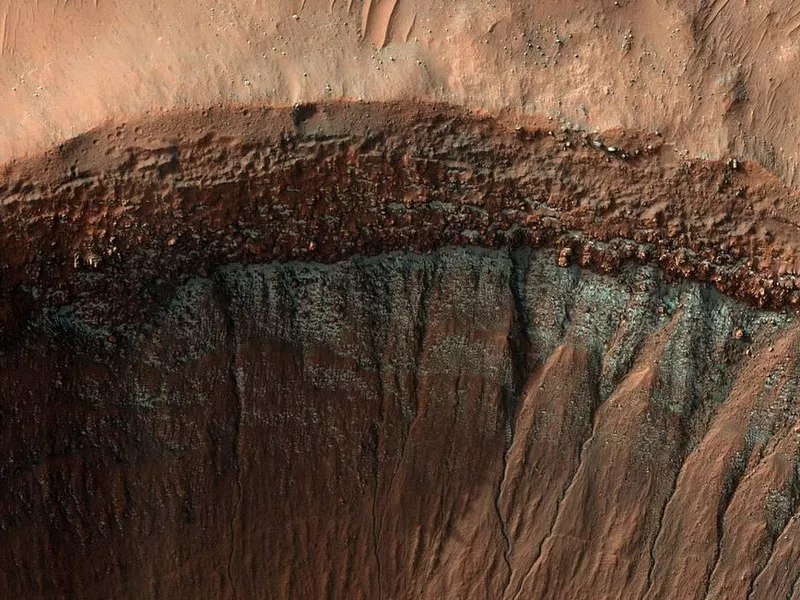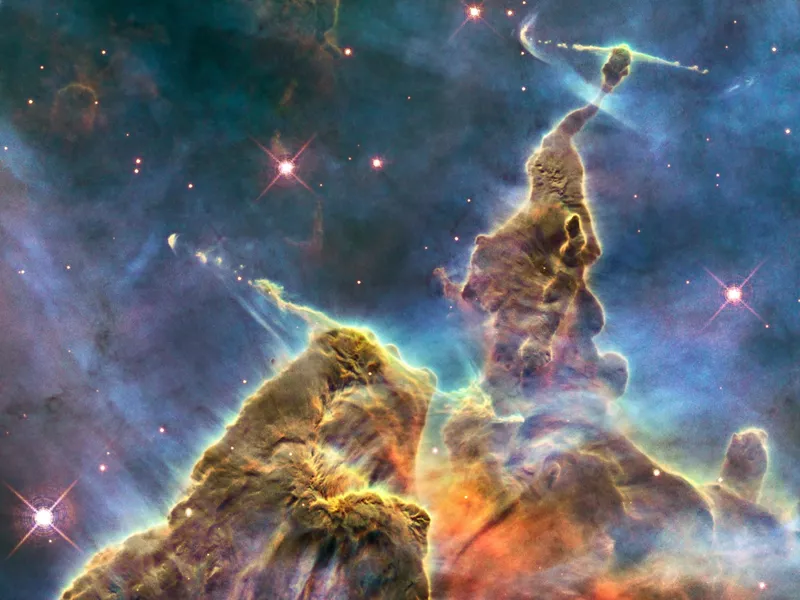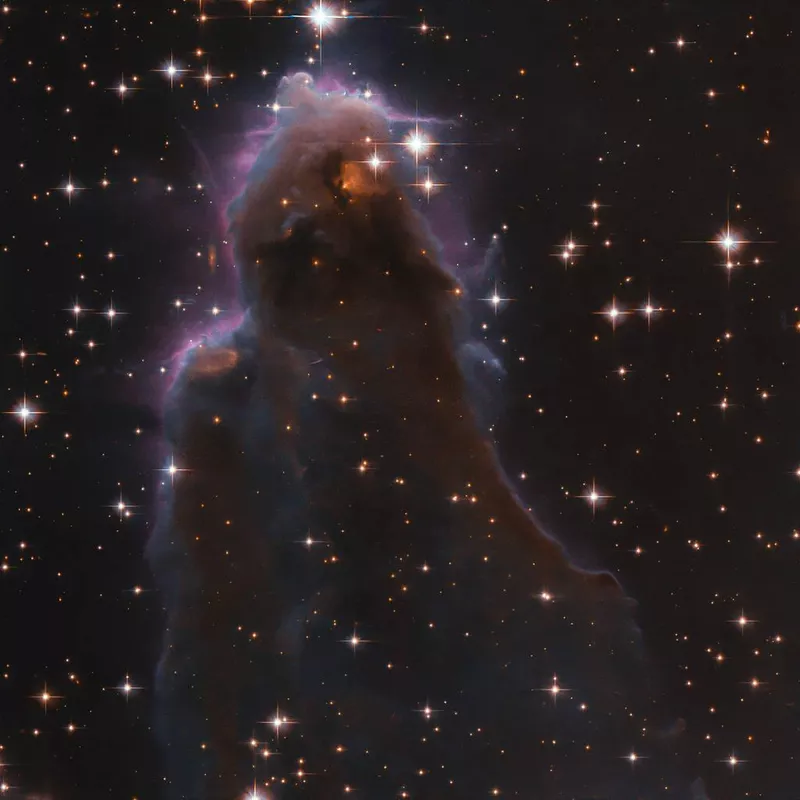There’s no better time to get kids excited about science since NASA released photos from space taken by the most powerful telescope ever built — the James Webb Space Telescope. These are part of an impressive backlog of NASA Image of the Day visuals that date back to the start of the National Aeronautics and Space Administration in 1958.
Dazzling interstellar clouds, baby stars being born and magnificent views of Earth are just some of the subjects used for the NASA picture of the day. We rounded up some of the best images to set your gaze upon.
Earth From Orbit
The National Oceanic and Atmospheric Administration shared the first images of the Western Hemisphere from its Geostationary Operational Environmental Satellite-T (GOES-T).
Jovian Vortex

NASA/JPL-Caltech/SwRI/MSSS/Kevin M. Gill / NASA
Ever wonder what a cyclonic storm looks like in Jupiter’s atmosphere?
This was taken during space-probe Juno’s 23rd close flyby of the planet.
Space Butterfly
Believe it or not, this infrared image taken by NASA’s Spitzer Space Telescope highlights a nursery for hundreds of baby stars.
Night Skies and National Parks

NASA Earth Observatory / NASA
This composite image of the U.S. was taken in 2012 to represent the night skies.
Huge Rings Around a Black Hole

NASA/CXC/U.Wisc-Madison/S. Heinz et al.; Optical/IR: Pan-STARR / NASA
This image features a spectacular set of rings around a black hole.
Ice on Mars

JPL-Caltech / University of Arizona / NASA
Every winter, a layer of dry ice forms on Mars’ surface.
At its height in mid-winter, this frost reaches from the poles down to the middle latitudes, until it is too warm to continue.
Orbital Sunset
Crew members from the International Space Station flying 258 miles above Brazil captured these last rays of an orbital sunset bursting through Earth’s horizon.
Hubble Views an Infant Star’s Outburst

ESA/Hubble & NASA, B. Nisini / NASA
A stellar tantrum produced by an extremely young star in the earliest phase of formation consists of an incandescent jet of gas traveling at supersonic speeds.
The Carina Nebula’s ‘Mystic Mountain’

NASA, ESA, M. Livio and the Hubble 20th Anniversary Team (STScI) / NASA
This three-light-year-tall pinnacle consists primarily of an expanding shell of gas and dust (known as a nebula) with signs of intense star-forming activity.
This composite image shows colors that represent the glow of oxygen (blue), hydrogen and nitrogen (green) and sulfur (red).
International Space Station Transits the Sun
This composite image of the International Space Station was made from seven frames and highlights a crew of seven on board.
Baby Stars
This infrared image shows tons of baby stars covered by dust in the star-forming region NGC 2174.
Shock Wave of Colliding Gases

NASA, ESA, and J. Bally (University of Colorado at Boulder); Processing: Gladys Kober (NASA/Catholic University of America / NASA
Luminous clouds of gas and dust glow in this Hubble image of a Herbig-Haro object, a rare type of nebula that occurs when a newborn star ejects hot gas after colliding with the gas and dust around it at hundreds of miles per second.
This is what creates the bright shock waves.
Aurora Over the Southern Skies
A vivid aurora streams over the Earth as the International Space Station orbits 274 miles above the southern Indian Ocean between Australia and Antarctica.
Barred Spiral Galaxy

ESA/Hubble & NASA, M. Sun / NASA
This image shows a barred spiral galaxy roughly 57 million light-years from the Milky Way in the constellation Centaurus.
Earth from the Space Station
While orbiting the Earth, the International Space Station crew took this image of the blue-green waters around the Bahamas.
Face on the Sun

NASA/GSFC/SDO / NASA
Active regions on the sun give it the appearance of a jack-o’-lantern.
The Lagoon Nebula

X-ray: NASA/CXC/SAO; Optical: Adam Block/Mount Lemmon SkyCenter/University of Arizona / NASA
Known as NGC 6523 or the Lagoon Nebula, Messier 8 is a giant cloud of gas and dust where stars are born.
Star AG Carinae
This star is surrounded by a nebula that is shaped by the powerful winds emanating from the star.
R Aquarii: An Expanse of Light

X-ray: NASA/CXC/SAO; Optical: NASA/STScI, Palomar Observatory, DSS; Radio: NSF/NRAO/VLA; H-Alpha: LCO/IMACS/MMTF / NASA
This object is made up of a white dwarf star that steadily burns at a relatively cool temperature and a highly variable red giant.
Supernova Remnant

NASA/ESA/HEIC and The Hubble Heritage Team (STScI/AURA) / NASA
A violent and chaotic-looking mass of gas and dust is seen in this Hubble Space Telescope image of a nearby supernova remnant.
3.6 Billion Years in Pastel Colors

NASA/METI/AIST/Japan Space Systems, and U.S./Japan ASTER Science Team / NASA
The Pilbara in northwestern Australia exposes some of the oldest rocks on Earth, including ones that are over 3.6 billion years old.
Partial Solar Eclipse
This image of a partial solar eclipse was taken behind the U.S. Capitol Building.
Special Stellar Nursery

ESA/Hubble & NASA, R. Sahai / NASA
This picture highlights a massive new star beginning to form.
Two Doomed Stars

ESA/Hubble & NASA, K. Noll / NASA
Dubbed the “Necklace Nebula,” this planetary nebula is located 15,000 light-years away from Earth in a constellation called Sagitta (The Arrow).
View of Earth’s Horizon
The Expedition 7 crew took this picture of Earth’s horizon as the sun sets over the Pacific Ocean while onboard the International Space Station in 2003.
Detecting X-Rays From Uranus

X-ray: NASA/CXO/University College London/W. Dunn et al; Optical: W.M. Keck Observatory / NASA
This image taken in March 2021 show was taken by astronomers using NASA’s Chandra X-ray Observatory.
Young Stars
These Chandra observations show the first X-ray emission from young stars with masses similar to our sun outside our Milky Way galaxy.
Qasar
Using NASA’s Hubble Space Telescope, a team of astronomers captured one of the most energetic outflows ever witnessed in the universe.
Cyclones of Color at Jupiter’s North Pole

Gerald Eichstädt / NASA
This image from NASA’s Juno space probe capture cyclones at the north pole of Jupiter, which appear as swirls of striking colors.
Galactic Glamour Shot
This stunning image from NASA’s Hubble Space Telescope features a spiral galaxy about 60 million light-years from Earth.